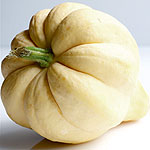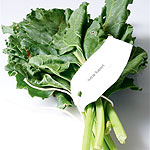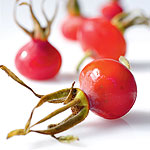Flavours of September
After a productive summer of sunshine and showers, there's plenty of high-quality produce ready for harvest. Madalene Bonvini-Hamel, creator of the online recipe diary Britishlarder.co.uk, explains what's in season as autumn approaches.
The summer has been good for us, with a balance of rain showers and sunshine. The farmers are working against the clock to collect their crops, and country lanes and arable farmland are heaving with harvesting activity.
The game season has begun, but because of the warm weather the game birds have been reluctant to eat and so are a bit on the thin side at the moment. After a bit of rain and cooler weather, however, the partridges, wild ducks and guinea fowl will be perfect to cook with.
The beginning of autumn is the perfect time to forage for wild food and fruit. In a humid atmosphere after a good downpour wild mushrooms start popping up everywhere, with giant puffballs, chanterelles, slippery jack, cauliflower fungus, fairy rings, porcini, beefsteak mushrooms and large, flat field mushrooms on offer.
Elderberries and damsons, along with sloes, rowanberries, wild plums, greengages, crab apples and rosehips are ready to be picked and turned into wonderful jams, pickles, vinaigrettes or jellies for the winter months ahead.
From the coast, there is also plenty to choose from, including sea beet, sea plantain, sea aster, sea purslane and sea blight, which is crisp and lavishly green. They benefit from quick cooking, either by being blanched in rapidly boiling water or sautéd in a drop of olive oil.
The tastiest way of cooking squash is by roasting it in a hot oven, with skin and all, until tender. Choose young squash with a thin, tender skin. The skin keeps the flesh together and adds extra texture to the dish, as in the oven-roasted heritage squash and salt-baked beet salad with a hen's egg and rosehip and elderberry vinaigrette.
Scottish langoustines are superb and are best when bought while still alive. They do turn very quickly, however, so should be prepared with caution and as quickly as possible.
For a taste of the sea, prepare the langoustines with a selection of sea vegetables, such as sea plantain and sea beet as per the sautéd flounder and langoustine salad with sea beet and plantain, sultana and caper vinaigrette recipe.
As flounder is a small flat fish it's best cooked on the bone to ensure the flesh is kept moist. However, if filleted, as in the sautéd flounder and langoustine salad dish, then be sure to cook the flounder quickly in a very hot pan for a short period of time.
Sea beet (pictured) is a member of the chenopodiaceae family and grows wild around British coastal shores. It is a wild relative of the common sugar beet, Swiss chard and beetroot, with a prominent earthy taste. Hence the combination with the flounder and langoustines works extremely well in the sautéd flounder and langoustine salad recipe.
Mainly known for its use as an ornamental tree and growing wild in hedgerows as a smallish shrub, the fruits of the crab apple are not normally considered for culinary use. They are extremely bitter with a high natural pectin content. This lends itself to making wonderful jellies to accompany dishes such as the slow-cooked belly of pork with crab apple jelly and caramelised damsons (opposite).
The belief is that you should wait until after the first frost before harvesting rosehips and sloes, the reason being that they are more tender and ripe. If you do harvest them earlier, remember to cook them for slightly longer to extract the most flavour, as in the recipe for oven-roasted heritage squash and salt-baked beet salad.
SLOW-COOKED BELLY OF PORK WITH CRAB APPLE JELLY AND CARAMELISED DAMSONS
For the slow-cooked pork belly • 1kg belly of pork, skin removed and fat trimmed evenly
• 30ml honey
• 40ml soy sauce
• 40ml Port
• 2 whole cinnamon sticks
• 2 bay leaves
• 1 clove of garlic lightly crushed
• 1tsp coriander seeds
For the crab apple jelly • 1kg crab apples, cleaned and cut in half
• Juice of one lemon
• 700g caster sugar
For the caramelised damsons
• 8 damsons
• 1tbs caster sugar
• 1tbs unsalted butter
• 1 clove, crushed
METHOD
Slow-cooked pork belly Heat the water bath to 83°C. Prepare the pork belly by removing all the hairs with a razor.
Stir the rest of the ingredients together to make the marinade.
Put the belly of pork into a large vacuum bag and add the marinade. Seal the belly twice on hard vacuum - the vacuum opens the pores of the pork and the marinade penetrates faster and more effectively.
Cook the pork belly in the preheated water bath for 12 hours, then chill the cooked pork in iced water and refrigerate until needed.
Once the pork is cold and set, cut into portion sizes.
Crab apple jelly Wash the wild apples a couple of times in clean cold water, using a nailbrush to remove any dirt and a sharp paring knife to remove bruises.
Cut the apples in half, then place in a large saucepan and cover with cold water. Use a small side plate to weigh the apples down to prevent them from floating.
Bring the apples to the boil, reduce the heat and simmer for 30 minutes. Turn the heat off and let the apples cool completely.
Pour the apples into a jelly bag or large sieve lined with muslin and let it hang overnight to ensure that all the goodness passes into the liquid.
The following day, measure the liquid: use 10 parts of apple liquid to seven parts of caster sugar.
Place the sugar, liquid and lemon juice in a large saucepan and bring to the boil. After removing the impurities, turn to a gentle simmer. Do not boil too fast as it will make the jelly cloudy, but continue to cook the jelly for 40-45 minutes.
Test the jelly by chilling a small plate in the fridge, then pour a tablespoon of jelly on to the cold plate. If the jelly sets and you can run your finger through it and it does not run, then it is ready.
Let the jelly cool slightly before you pour it into warm, clean sterilised glass jars.
Allow the crab apple jelly to set completely before serving.
Caramelised damsons Wash the damsons, cut in half and remove the stones.
Heat butter in a large non-stick frying pan until it foams. Toss the damsons in the sugar and crushed clove and sauté them in the foaming butter until golden brown and caramelised. Lightly season with salt and pepper. Drain on kitchen paper.
To serve Heat a non-stick frying pan with a bit of butter, and caramelise the pork belly until golden and heated all the way through.
Serve the pork on mashed potato, port-braised turnip and caramelised damsons, with the crab apple jelly on the side. Drizzle with rapeseed oil and port sauce. Serve immediately.
OVEN-ROASTED HERITAGE SQUASH AND SALT-BAKED BEET SALAD WITH A HEN'S EGG AND ROSEHIP AND ELDERBERRY VINAIGRETTE
For the oven-roasted heritage squash • 1 large squash
• 2tbs ras el hanout
• Maldon sea salt and freshly cracked black pepper
For the salt-baked beetroot • 4 whole fresh beetroots
• 200g fleur de sel or coarse sea salt
For the pickled cauliflower • 1 head of cauliflower
• 100ml olive oil
• Maldon sea salt and freshly cracked black pepper
• 1tsp ras el hanout
For the rosehip and elderberry vinaigrette • 400ml Aspall cider vinegar
• 400g caster sugar
• 200g elderberries
• 15 ripe rosehips
• 100ml olive oil
• Salt
METHOD
Oven-roasted heritage squash Preheat the oven to 200°C. Wash the squash, cut into pieces, mix with the oil, seasoning and ras el hanout. Place the squash on a baking tray and roast the squash in the oven until tender and golden brown. Leave to chill.
Salt-baked beetroot Preheat the oven to 160°C. Wash the beetroot and pack the salt around the beetroot, place on a roasting tray and bake the beetroot for two hours until tender.
Leave to cool, peel the skin and cut the beetroot into smaller pieces.
Pickled cauliflower Preheat the oven to 200°C. Cut the cauliflowers into small florettes.
Mix the cauliflower with the oil, ras el hanout and seasoning. Spread on a baking tray.
Roast the cauliflowers in the oven for 10 minutes and chill.
Rosehip and elderberry vinaigrette Cut the rosehips in half and remove the seeds. Place the rosehips, sugar and vinegar in a saucepan. Dissolve the sugar and bring to the boil. Reduce by half, add the elderberries and remove from the heat. Leave to infuse for two hours.
Season to taste and stir in the olive oil.
Chill until needed.
To serve Soft-boil two eggs. Peel and cut them in half. Arrange the squash, beet and cauliflower with the egg on the plate. Season, and spoon the vinaigrette over. Place a few sprigs of baby cress leaves on top and serve.
SAUTED FLOUNDER AND LANGOUSTINE SALAD WITH SEA BEET AND SEA PLANTAIN, SULTANA AND CAPER VINAIGRETTE
For the sautéd flounder and langoustines • 2 flounder
• 24 langoustine tails
• ½tsp mild curry powder
• Maldon sea salt
• Olive oil
For the sultana and caper vinaigrette • 200g sultanas
• 200ml apple juice
• 200g capers, drained
• 25ml olive oil
• Salt and freshly cracked black pepper
For the sea beet and plantain salad • 8 sea beet leaves
• 24 sea plantain leaves
• Olive oil
METHOD
Sautéd flounder and langoustines Fillet the flounder and cut each fillet into two pieces.
Mix the mild curry powder with three parts of salt. Season the flounder and langoustines lightly with the curried salt.
Heat a non-stick frying pan with oil and sauté the flounder and langoustines for three minutes until golden brown.
Drain on kitchen paper before serving.
Sultana and caper vinaigrette Heat the apple juice to 40°C and soak the sultanas for 30 minutes. Drain the capers and blend with the sultanas, apple juice and olive oil to a smooth purée. Pass the purée through a fine sieve. Season to taste. Transfer the purée into a squeeze bottle and chill until needed.
Sea beet and sea plantain salad Wash the sea beet and plantain. Bring a pan of water to the boil and blanch the sea beet and plantain in the boiling water. Drain, and glaze with a bit of olive oil.
To serve Arrange the sea beet and plantain on the plate. Dot the sultana and caper dressing on the plate and place the flounder and langoustines. Serve immediately.
MY FAVOURITE SUPPLIERS: MADALENE BONVINI-HAMEL, BRITISH LARDER SUFFOLK
SUFFOLK PORK
Dingley Dell PorkContact: Mark Hayward, Ashmoor Hall Farm, Campsea Ashe, Woodbridge, Suffolk IP13 OPG
01728 748097
CHEESE
Hamish Johnston Cheese
Contact: Will Johnston, Unit 6, Ore Trading Estate, Framlingham, Suffolk IP13 9LL
01394 450210
SMOKE HOUSE AND OYSTERAGE
Pinney's of Orford
Contact: Harry, The Old Warehouse, Quay Street, Orford IP12 2NU
01394 450210
ORGANIC AND FREE-RANGE TABLE BIRDSSutton Hoo ChickensContact: Will Waterer, Kennel Farm, Hasketon, Woodbridge IP13 6JX
01394 386797
FRUIT AND VEGETABLES
Accent Fresh Contact: Stephen Short, St John's Business Estate, Downham Market, PE38 OQQ
01366 386633
FRUIT
High House Farm Contact: Pierce, Sudbourne, Woodbridge, Suffolk IP12 2BL
07821 266046
BREAD
Metfield Bakery
Contact: Carl Pike, 23 Charles Wood Road, Rash's Green Industrial Estate, Dereham, Norfolk NR19 1SX


















